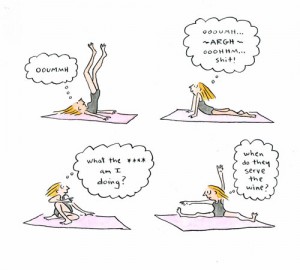Yoga’s secret ingredient for the busy mind
3Students come to yoga classes for all kinds of reasons. Along with the most common ones of stretching, exercising and the like, I often hear “to get out of my head”. What does it mean and how exactly does yoga help accomplish that?
I love this image that Buddhists use to describe our usual state of mind – the “monkey mind”. I can imagine my thoughts behaving just like monkeys – swinging from limb to limb, suddenly changing direction and maybe even occasionally throwing something unsightly at passersby.
If we let them run wild, our thoughts swing wildly from one idea to the next. This is understandable – after all it’s your mind’s job to process a huge load of information every minute. In and out of itself it can be pretty tiring to juggle so many pieces of information. Then there is a bigger problem of emotional associations. While some thoughts are neutral in their emotional coloring, many others carry an emotional charge, meaning that happy thoughts carry us up to the top of the world, but then quickly – whoop! – we swing again into worry and frustration, following the next unpleasant thought that comes along. So the sheer amount of information and the emotional rollercoaster that comes with it take a toll on how we move through our days and perceive our lives in general.
Fundamentally, yoga is about controlling the fluctuation of the mind, meaning taking charge of those monkeys’ behavior and gradually reducing the emotional charge associated with specific thoughts. Theoretically, any yoga practice should help the student focus the mind and attain some sort of inner equilibrium. From our own experience we know that this is not always the case. If the mind is used to jumping from place to place at break-neck speed, it is not so easy to tame it and make it calm. We can’t really stop thinking (nor should we). So if we just bark at the mind : “Be quiet, stop it”, it will only become more agitated. That’s why many people say: “I can’t meditate, my mind is too busy”. I am sorry to say – everybody’s mind is busy. Some people just became more skilled at redirecting the mind’s activity and helping it focus on something useful rather then letting it roam free.
This is the secret ingredient according to the yoga tradition – one pointed focus. It means that you pick some object, idea or technique and you hook your attention to it and try to maintain that focus for as long as you can. You do it all the time in your daily life anyway. When you are absorbed in your work or doing something that you really enjoy, or play sports or whatever – you are there, you are focused. They call it “being in the zone”, but it simply means being fully present with what you are doing. So when we say “get out of my head”, we usually mean “stop compulsive thinking and be fully present”. And the more often you do it, the easier it becomes. That’s why practicing one-pointed focus in your yoga practice is so important – it helps you get out of the usual monkey-mind state, focus your mind and then carry that skill into your day-to-day life.
As yoga teachers we need to be able to help our students “hook” their attention, otherwise we end up with distracted students who are going through the motions out of habit, but are thinking about something completely unrelated. If we let them do that, they might still get some physical benefit from the practice, but will miss out on the most important one of focusing the mind (and increase their risk of injury).
Simply saying “pay attention!” is never enough, but there are proven tricks that we can use to capture student’s attention and help them be more present with what they are doing. This will be the topic of our conversation next time. Tune in!
[jetpack_subscription_form]






















Love where this is going. My question is, do we ask the student or do we tell them? I have been in several classes where I am told that I should be feeling a certain way, but when i don’t then I start thinking to myself why don’t I? What’s wrong with what I am doing? And as you say write in your blog the Monkey brain starts going into overdrive? I look forward to your next blog.
Thank you for your comment Larry – I couldn’t agree more! I think that there is a big difference between directing student’s attention and trying to control their experience. Thank you for bringing this up, I will be sure to include it in the next post!
Love this! I always remind my self when I am teaching, a good teacher shows the way but doesnt tell you what to see. I agree holding the space for students to focus the mind is important, thats why quiet & stillness at the beginning and longer at the end of class is a must, no doubts! Using the word Your Body, Your breath rather than, you should feel this…etc etc, notice the sensations and all sensations are good sensations! I like to speak about the thinking mind, so people can get perspective and understand why sometimes you mind goes crazy jumping here there an everywhere! Describing the difference between the thinking mind and working mind and how that can give focus, gives Students there on keys to unlock doors. Oh and it takes practice, so just be with what is present in YOUR body.